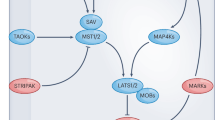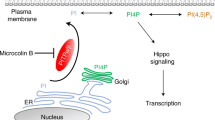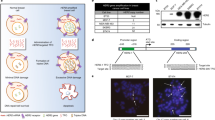Abstract
The Hippo pathway is an evolutionarily conserved pathway that controls cell proliferation, organ size, tissue regeneration and stem cell self-renewal. Here we show that it also regulates the DNA damage response. At high cell density, when the Hippo pathway is active, DNA damage-induced apoptosis and the activation of the tyrosine kinase c-Abl were suppressed. At low cell density, overexpression of the Hippo pathway kinase large tumor suppressor 2 (Lats2) inhibited c-Abl activity. This led to reduced phosphorylation of downstream c-Abl substrates, the transcription coactivator Yes-associated protein (Yap) and the tumor suppressor p73. Inhibition of c-Abl by Lats2 was mediated through Lats2 interaction with and phosphorylation of c-Abl. Lats2 knockdown, or expression of c-Abl mutants that escape inhibition by Lats2, enabled DNA damage-induced apoptosis of densely plated cells, while Lats2 overexpression inhibited apoptosis in sparse cells. These findings explain a long-standing enigma of why densely plated cells are radioresistant. Furthermore, they demonstrate that the Hippo pathway regulates cell fate decisions in response to DNA damage.
Similar content being viewed by others
Log in or create a free account to read this content
Gain free access to this article, as well as selected content from this journal and more on nature.com
or
Abbreviations
- ASPP:
-
apoptosis-stimulating protein of p53
- c-Abl (ABL1):
-
Abelson tyrosine protein kinase 1
- Arg (ABL2):
-
Abl-related gene
- EMT:
-
epithelial to mesenchymal transition
- FACS:
-
fluorescence-activated cell sorting
- Lats:
-
large tumor suppressor
- Mdm:
-
mouse double minute
- Mst:
-
mammalian STE20-like protein kinase
- PARP:
-
poly ADP-ribose polymerase
- RASSF:
-
RAS association domain family
- Rb:
-
retinoblastoma
- Taz:
-
transcription coactivator with PDZ-binding motif
- WW45:
-
45 kDa WW domain protein
- Yap:
-
Yes-associated protein
References
Vousden KH, Prives C . Blinded by the light: the growing complexity of p53. Cell 2009; 137: 413–431.
Beckerman R, Prives C . Transcriptional regulation by p53. Cold Spring Harbor Perspect Biol 2010; 2: a000935.
Bar J, Cohen-Noyman E, Geiger B, Oren M . Attenuation of the p53 response to DNA damage by high cell density. Oncogene 2004; 23: 2128–2137.
Pan D . The hippo signaling pathway in development and cancer. Dev Cell 2010; 19: 491–505.
Pan D . Hippo signaling in organ size control. Genes Dev 2007; 21: 886–897.
Zhao B, Li L, Lei Q, Guan KL . The Hippo-YAP pathway in organ size control and tumorigenesis: an updated version. Genes Dev 2010; 24: 862–874.
Lian I, Kim J, Okazawa H, Zhao J, Zhao B, Yu J et al. The role of YAP transcription coactivator in regulating stem cell self-renewal and differentiation. Genes Dev 2010; 24: 1106–1118.
Cordenonsi M, Zanconato F, Azzolin L, Forcato M, Rosato A, Frasson C et al. The Hippo transducer TAZ confers cancer stem cell-related traits on breast cancer cells. Cell 2011; 147: 759–772.
Zhao B, Wei X, Li W, Udan RS, Yang Q, Kim J et al. Inactivation of YAP oncoprotein by the Hippo pathway is involved in cell contact inhibition and tissue growth control. Genes Dev 2007; 21: 2747–2761.
Lei QY, Zhang H, Zhao B, Zha ZY, Bai F, Pei XH et al. TAZ promotes cell proliferation and epithelial-mesenchymal transition and is inhibited by the hippo pathway. Mol Cell Biol 2008; 28: 2426–2436.
Zhao B, Li L, Tumaneng K, Wang CY, Guan KL . A coordinated phosphorylation by Lats and CK1 regulates YAP stability through SCF(beta-TRCP). Genes Dev 2010; 24: 72–85.
Zhang H, Liu CY, Zha ZY, Zhao B, Yao J, Zhao S et al. TEAD transcription factors mediate the function of TAZ in cell growth and epithelial-mesenchymal transition. J Biol Chem 2009; 284: 13355–13362.
Wu S, Liu Y, Zheng Y, Dong J, Pan D . The TEAD/TEF family protein Scalloped mediates transcriptional output of the Hippo growth-regulatory pathway. Dev Cell 2008; 14: 388–398.
Zhao B, Ye X, Yu J, Li L, Li W, Li S et al. TEAD mediates YAP-dependent gene induction and growth control. Genes Dev 2008; 22: 1962–1971.
Ota M, Sasaki H . Mammalian Tead proteins regulate cell proliferation and contact inhibition as transcriptional mediators of Hippo signaling. Development 2008; 135: 4059–4069.
Zhang L, Ren F, Zhang Q, Chen Y, Wang B, Jiang J . The TEAD/TEF family of transcription factor Scalloped mediates Hippo signaling in organ size control. Dev Cell 2008; 14: 377–387.
Strano S, Munarriz E, Rossi M, Castagnoli L, Shaul Y, Sacchi A et al. Physical interaction with Yes-associated protein enhances p73 transcriptional activity. J Biol Chem 2001; 276: 15164–15173.
Yuan ZM, Shioya H, Ishiko T, Sun X, Gu J, Huang YY et al. p73 is regulated by tyrosine kinase c-Abl in the apoptotic response to DNA damage. Nature 1999; 399: 814–817.
Gong JG, Costanzo A, Yang HQ, Melino G, Kaelin WG Jr., Levrero M et al. The tyrosine kinase c-Abl regulates p73 in apoptotic response to cisplatin-induced DNA damage. Nature 1999; 399: 806–809.
Agami R, Blandino G, Oren M, Shaul Y . Interaction of c-Abl and p73alpha and their collaboration to induce apoptosis. Nature 1999; 399: 809–813.
Levy D, Adamovich Y, Reuven N, Shaul Y . Yap1 phosphorylation by c-Abl is a critical step in selective activation of proapoptotic genes in response to DNA damage. Mol Cell 2008; 29: 350–361.
Levy D, Reuven N, Shaul Y . A regulatory circuit controlling Itch-mediated p73 degradation by Runx. J Biol Chem 2008; 283: 27462–27468.
Radu M, Chernoff J . The DeMSTification of mammalian Ste20 kinases. Curr Biol 2009; 19: R421–R425.
Matallanas D, Romano D, Yee K, Meissl K, Kucerova L, Piazzolla D et al. RASSF1A elicits apoptosis through an MST2 pathway directing proapoptotic transcription by the p73 tumor suppressor protein. Molecular cell 2007; 27: 962–975.
Aylon Y, Ofir-Rosenfeld Y, Yabuta N, Lapi E, Nojima H, Lu X et al. The Lats2 tumor suppressor augments p53-mediated apoptosis by promoting the nuclear proapoptotic function of ASPP1. Genes Dev 2010; 24: 2420–2429.
Zhao B, Li L, Wang L, Wang CY, Yu J, Guan KL . Cell detachment activates the Hippo pathway via cytoskeleton reorganization to induce anoikis. Genes Dev 2012; 26: 54–68.
Overholtzer M, Zhang J, Smolen GA, Muir B, Li W, Sgroi DC et al. Transforming properties of YAP, a candidate oncogene on the chromosome 11q22 amplicon. Proc Natl Acad Sci USA 2006; 103: 12405–12410.
Hao Y, Chun A, Cheung K, Rashidi B, Yang X . Tumor suppressor LATS1 is a negative regulator of oncogene YAP. J Biol Chem 2008; 283: 5496–5509.
Oka T, Mazack V, Sudol M . Mst2 and Lats kinases regulate apoptotic function of Yes kinase-associated protein (YAP). J Biol Chem 2008; 283: 27534–27546.
Goldberg Z, Vogt Sionov R, Berger M, Zwang Y, Perets R, Van Etten RA et al. Tyrosine phosphorylation of Mdm2 by c-Abl: implications for p53 regulation. EMBO J 2002; 21: 3715–3727.
Zuckerman V, Lenos K, Popowicz GM, Silberman I, Grossman T, Marine JC et al. c-Abl phosphorylates Hdmx and regulates its interaction with p53. J Biol Chem 2009; 284: 4031–4039.
Brasher BB, Van Etten RA . c-Abl has high intrinsic tyrosine kinase activity that is stimulated by mutation of the Src homology 3 domain and by autophosphorylation at two distinct regulatory tyrosines. J Biol Chem 2000; 275: 35631–35637.
Pluk H, Dorey K, Superti-Furga G . Autoinhibition of c-Abl. Cell 2002; 108: 247–259.
Yu H, Chen JK, Feng S, Dalgarno DC, Brauer AW, Schreiber SL . Structural basis for the binding of proline-rich peptides to SH3 domains. Cell 1994; 76: 933–945.
Crooks GE, Hon G, Chandonia JM, Brenner SE . WebLogo: a sequence logo generator. Genome Res 2004; 14: 1188–1190.
Brasher BB, Roumiantsev S, Van Etten RA . Mutational analysis of the regulatory function of the c-Abl Src homology 3 domain. Oncogene 2001; 20: 7744–7752.
Ben-Yehoyada M, Ben-Dor I, Shaul Y . c-Abl tyrosine kinase selectively regulates p73 nuclear matrix association. J Biol Chem 2003; 278: 34475–34482.
Midgley CA, Owens B, Briscoe CV, Thomas DB, Lane DP, Hall PA . Coupling between gamma irradiation, p53 induction and the apoptotic response depends upon cell type in vivo. J Cell Sci 1995; 108 Pt 5 1843–1848.
MacCallum DE, Hupp TR, Midgley CA, Stuart D, Campbell SJ, Harper A et al. The p53 response to ionising radiation in adult and developing murine tissues. Oncogene 1996; 13: 2575–2587.
Gottlieb E, Haffner R, King A, Asher G, Gruss P, Lonai P et al. Transgenic mouse model for studying the transcriptional activity of the p53 protein: age- and tissue-dependent changes in radiation-induced activation during embryogenesis. EMBO J 1997; 16: 1381–1390.
Komarova EA, Chernov MV, Franks R, Wang K, Armin G, Zelnick CR et al. Transgenic mice with p53-responsive lacZ: p53 activity varies dramatically during normal development and determines radiation and drug sensitivity in vivo. EMBO J 1997; 16: 1391–1400.
Wilson JW, Pritchard DM, Hickman JA, Potten CS . Radiation-induced p53 and p21WAF-1/CIP1 expression in the murine intestinal epithelium: apoptosis and cell cycle arrest. Am J Pathol 1998; 153: 899–909.
Camargo FD, Gokhale S, Johnnidis JB, Fu D, Bell GW, Jaenisch R et al. YAP1 increases organ size and expands undifferentiated progenitor cells. Curr Biol 2007; 17: 2054–2060.
Dick FA, Mymryk JS . Sweet DREAMs for Hippo. Genes Dev 2011; 25: 889–894.
Nicolay BN, Bayarmagnai B, Islam AB, Lopez-Bigas N, Frolov MV . Cooperation between dE2F1 and Yki/Sd defines a distinct transcriptional program necessary to bypass cell cycle exit. Genes Dev 2011; 25: 323–335.
Tschop K, Conery AR, Litovchick L, Decaprio JA, Settleman J, Harlow E et al. A kinase shRNA screen links LATS2 and the pRB tumor suppressor. Genes Dev 2011; 25: 814–830.
Litovchick L, Florens LA, Swanson SK, Washburn MP, DeCaprio JA . DYRK1A protein kinase promotes quiescence and senescence through DREAM complex assembly. Genes Dev 2011; 25: 801–813.
Sirvent A, Benistant C, Roche S . Cytoplasmic signalling by the c-Abl tyrosine kinase in normal and cancer cells. Biol Cell 2008; 100: 617–631.
Colicelli J . ABL tyrosine kinases: evolution of function, regulation, and specificity. Sci Signal 2010; 3: re6.
Plattner R, Kadlec L, DeMali KA, Kazlauskas A, Pendergast AM . c-Abl is activated by growth factors and Src family kinases and has a role in the cellular response to PDGF. Genes Dev 1999; 13: 2400–2411.
Srinivasan D, Sims JT, Plattner R . Aggressive breast cancer cells are dependent on activated Abl kinases for proliferation, anchorage-independent growth and survival. Oncogene 2008; 27: 1095–1105.
Tanos B, Pendergast AM . Abl tyrosine kinase regulates endocytosis of the epidermal growth factor receptor. J Biol Chem 2006; 281: 32714–32723.
Woodring PJ, Hunter T, Wang JY . Regulation of F-actin-dependent processes by the Abl family of tyrosine kinases. J Cell Sci 2003; 116 (Pt 13): 2613–2626.
Sawyers CL . Chronic myeloid leukemia. New Engl J Med 1999; 340: 1330–1340.
Levy D, Adamovich Y, Reuven N, Shaul Y . The Yes-associated protein 1 stabilizes p73 by preventing Itch-mediated ubiquitination of p73. Cell and Differentiation 2007; 14: 743–751.
Okada N, Yabuta N, Suzuki H, Aylon Y, Oren M, Nojima H . A novel Chk1/2-Lats2-14-3-3 signaling pathway regulates P-body formation in response to UV damage. J Cell Sci 2011; 124 (Pt 1): 57–67.
Acknowledgements
We thank M Oren and Y Aylon for helpful discussion and for the myc-Lats2 constructs and reagents. We thank XJ Yang for the HA-Lats2, Mst1 and WW45 constructs. We thank G Superti-Furga for the pSLX c-Abl constructs. STI571 was kindly provided by Novartis Pharmaceuticals. We thank R Keshet for providing the pBabe Flag-Yap constructs, and M Elbaz for her technical assistance. This work was supported by grants from the Israel Science Foundation (grant no. 551/11), Israel Cancer Research Fund, the Cooperation Program in Cancer Research of the Deutsches Krebsforschungszentrum (DKFZ) and Israel’s Ministry of Science and Technology (MOST) and from the Minerva Foundation with funding from the Federal German Ministry for Education and Research.
Author information
Authors and Affiliations
Corresponding author
Ethics declarations
Competing interests
The authors declare no conflict of interest.
Additional information
Edited by B Zhivotovsky
Supplementary Information accompanies this paper on Cell Death and Differentiation website
Rights and permissions
About this article
Cite this article
Reuven, N., Adler, J., Meltser, V. et al. The Hippo pathway kinase Lats2 prevents DNA damage-induced apoptosis through inhibition of the tyrosine kinase c-Abl. Cell Death Differ 20, 1330–1340 (2013). https://doi.org/10.1038/cdd.2013.83
Received:
Revised:
Accepted:
Published:
Issue date:
DOI: https://doi.org/10.1038/cdd.2013.83
Keywords
This article is cited by
-
Inhibition of LATS kinases reduces tumorigenicity and increases the sensitivity of human chronic myelogenous leukemia cells to imatinib
Scientific Reports (2024)
-
Carcinogenesis promotion in oral squamous cell carcinoma: KDM4A complex-mediated gene transcriptional suppression by LEF1
Cell Death & Disease (2023)
-
Hippo pathway dysregulation in gastric cancer: from Helicobacter pylori infection to tumor promotion and progression
Cell Death & Disease (2023)
-
Live-cell imaging and mathematical analysis of the “community effect” in apoptosis
Apoptosis (2023)
-
SMG6 regulates DNA damage and cell survival in Hippo pathway kinase LATS2-inactivated malignant mesothelioma
Cell Death Discovery (2022)



